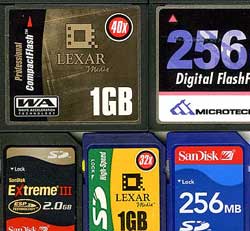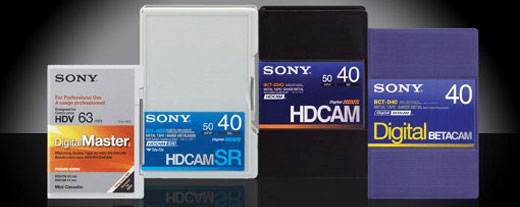Need help with a video project, send us your files and we can help!
With the announcement of the new Final Cut Pro X and other Non-Linear Editors (NLE) like Avid Media Composer moving more consumers into the pro-sumer market…the question begs an answer: is tape media dead? Outside of more consumers using non-video tape recording cameras, more and more pro-sumers and professionals are moving from tape media to SD media.
In a recent review by USA Today of the new Sony NX5U along with the emergence of using Digital SLRS to acquire video images…the claim is that video tape is dead. It is in the first line of this article: “Review: Sony NX5U video camera”. Jefferson Graham states, “The big takeaway from this week’s overhaul of Apple’s Final Cut Pro video editing software is that tape-based media is dead.”
Well here are my thoughts?
Storage costs money! Yes! Higher Definition images need more space to store these images! It all comes down to work flow…what do I mean, well we will address that in a second.
Traditional image acquisition in the video production world use video tape to record the image captured by the lens and processed by the camera. Once recorded on the tape, it would take equal amount of time to play and “ingest” into a computer’s non-linear editing suite (like Final Cut Pro, Avid Media Composer & Adrenaline, Adobe Premiere, etc.). Basically, if you recorded an hour’s worth of video, it would take an hour to put it into the computer.

When you use video tape, many production shops do not erase the original tape and save just in-case the original video information needs to be accessed. More video tape means more money. Thus, the transition to cameras that do not use video tape, it appears to cut down on cost.
BUT…here is the thing that keeps me still acquiring on video tape and recordable media like SD cards simultaneously. Once you put the video from a camera that records it without video tape into the computer, you have to save the original media somewhere. It requires hard drives to store this original media…because you erased it from the camera and it is not on an original video tape.
So…for the production house and the consumer, you have to find a place to store this original video media. For a production house…this turns into Terabytes and Terabytes of storage of this original footage. Now this storage costs can be passed off to the client…but it takes space. Bigger and bigger storage servers…and if you are storing on servers that use hard drives with moving parts, they can fail. Yes, you can RAID these drives…but I have met more and more and more major universities, production houses, etc. where the RAID’s fail and the original media is GONE!
Yes…I was at a major university that lost a whole season of football footage to a failed RAID system. Those hard drives are moving parts. Yes…there is solid state storage but it so damn expensive, it is hard to justify the costs with the new technology.
Avid’s NLE’s allow you to erase media that is unused in the editing process, but keep the parts of video production used in the final product. BUT…what if you want to re-access that un-used media for another project?
Here is what I do…my current solution.
1. I use a camera that can record on video tape and solid state storage simultaneously. The video tape is there just in-case the solid state media fails. It has happened before during my ingest. I have lost a whole day of shooting on an SD Card, but had the tape as a back-up. If not, it would have cost me time and money.
2. I ingest into the computer using Final Cut Pro with the solid state media card. Why, because it converts to a Quicktime (.MOV) that is widely excepted by most major NLE’s. I can also ingest 83 minutes of HDV in 7 minutes compared to the 87 minutes it would take for me to play that tape into the computer. Then…if I want to edit in Final Cut Pro or Avid…I have the original raw media digitally. (Avid has to convert the files to their proprietary codec)
3. I save the original HDV video tape as a back-up…properly labeled. So, if I loose the raw media on the hard drive, I can open the project and use the tapes to re-ingest the media.
4. I save the project files from both Final Cut Pro and Avid Media Composer in two other spots outside of the edit suite: a back-up storage drive and my online back-up space in the cloud. So, if I loose everything digitally, I have the original project files in two places and I can pull the tapes out to re-ingest the media.
5. I back-up my raw media files of the current years’ productions at a un-disclosed storage facility on consistent basis. This allows me to save time if my systems go down…just go get the media and transfer the files.
Why do I do this…because I do not trust moving parts in hard drives. I have had more NLE systems and their hard drives fail with media. I have watched major broadcasting units not be able to put on a show because files got corrupted with lost media. Tape is a physical media that provides a great back-up solution for original media.
Now, this is not always going to be a great solution long-term…but I am researching and working with partners on solutions that will provide me and my clients a great solution.
* Image Credit: Westside Media Group & Ken Rockwell
I get the question all the time, what do you use to edit video for your projects. That is actually a good question, one that is constantly discussed in our office. The quick and dirty answer is we use Final Cut Pro and Avid Media Composer on a Mac OS platform. Both are considered industry standard Non-Linear Editors or NLE’s.
Now what does that mean to the average customer, well it depends on your knowledge and experience. But from a final product standpoint, you will not see a difference in the final product. It is purely an individual editor’s preference. But this is how I try to help people understand…from my perspective.
I produce most web based video content using Final Cut Pro Studio. This is for many reasons, but mainly for workflow. I am extremely fluent with this software and their are many times that one person might be working on a project and a few months down the road, need to re-open the project for some reason. Another computer might need access to the project, so I can open from any of our Mac Computers.
Another reason for FInal Cut Pro Studio is that it integrates well with our web delivery workflow. It works in a Quicktime based file format; so when ever we encode (dump video into the software), Final Cut creates a native Quicktime that can viewed without the use of Final Cut software. That might be confusing to some…but makes life easy.
Final Cut Studio Pro is extremely intuitive so that a novice video editor can jump in and figure out how to use the software…especially if you have any video editing background.
Now…I am a trained/certified Avid Video Editor. I have been using Avid products since 1995 from the early days of the Avid NewsCutter Software. I started my career editing video using two video decks (essentially two Beta Decks side-by-side), editing from one tape to the next. This is considered editing in a Linear Method. Avid’s software (in my humble opinion) was design for those experienced editing using a Linear Method. I edit video using that mentality…and Avid Software fits me well.
Most experienced television video editors & producers have knowledge of Avid Software, so when I work with higher end production using workflow to deliver Standard Definition/High Definition content for television distribution…I use Avid Media Composer. It has all the 3D graphic editors and animation built into the system and works well with High Definition content. If I was to do the same with Final Cut Studio Pro, I would have to use After Effects and other 3rd Party Applications to execute what I can do in Avid Media Composer.
So, this discussion has some bottom-line thoughts.
1) Both Final Cut Studio Pro and Avid Media Composer software are professional grade video editing software.
2) It all depends of the Video Editing Professional and the project, this helps me decide which software I will use to best meet the demands of the workflow and final delivery of the project.
3) Both deliver a high quality final product, whether it is for the web, television, or other video delivery method.
4) I just like having gadgets….the more I have, the more fun it is for me to do our job!

